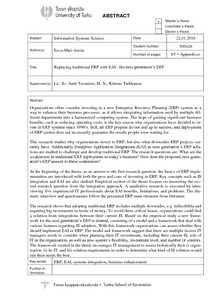Replacing traditional ERP with EAI - the next generation’s ERP
Airola, Eeva-Mari (2016-02-05)
Replacing traditional ERP with EAI - the next generation’s ERP
Airola, Eeva-Mari
(05.02.2016)
Julkaisun pysyvä osoite on:
https://urn.fi/URN:NBN:fi-fe201602054888
https://urn.fi/URN:NBN:fi-fe201602054888
Kuvaus
siirretty Doriasta
Tiivistelmä
Organizations often consider investing in a new Enterprise Resource Planning (ERP) system as a way to enhance their business processes, as it allows integrating information used by multiple different departments into a harmonized computing system. The hope of gaining significant business benefits, such as reducing operating costs, is the key reason why organizations have decided to invest in ERP systems since 1990’s. Still, all ERP projects do not end up in success, and deployment of ERP system does not necessarily guarantee the results people were waiting for.
This research studies why organizations invest in ERP, but also what downsides ERP projects currently have. Additionally Enterprise Application Integrations (EAI) as next generation’s ERP solutions are studied to challenge and develop traditional ERP. The research questions are: What are the weaknesses in traditional ERP deployment in today’s business? How does the proposed next generation’s ERP answer to these weaknesses?
At the beginning of the thesis, as an answer to the first research question, the basics of ERP implementation are introduced with both the pros and cons of investing in ERP. Key concepts such as IS integration and EAI are also studied. Empirical section of the thesis focuses on answering the second research question from the integration approach. A qualitative research is executed by interviewing five experienced IT professionals about EAI benefits, limitations, and problems. The thematic interview and questionnaire follow the presented ERP main elements from literature.
The research shows that adopting traditional ERP includes multiple downsides, e.g. inflexibility and requiring big investments in terms of money. To avoid these critical issues, organizations could find a solution from integrations between their current IS. Based on the empirical study a new framework for the next generation’s ERP is created, consisting of a model and a framework that deal with various features regarding IS adoption. With this framework organizations can assess whether they should implement EAI or ERP. The model and framework suggest that there are multiple factors IT managers needs to consider when planning their IT investments, including their current IS, role of IT in the organization, as well as new system’s flexibility, investment level, and number of vendors. The framework created in the thesis encourages IT management to assess holistically their i) organization, ii) its IT, and iii) solution requirements in order to determine what kind of IS solution would suit their needs the best.
This research studies why organizations invest in ERP, but also what downsides ERP projects currently have. Additionally Enterprise Application Integrations (EAI) as next generation’s ERP solutions are studied to challenge and develop traditional ERP. The research questions are: What are the weaknesses in traditional ERP deployment in today’s business? How does the proposed next generation’s ERP answer to these weaknesses?
At the beginning of the thesis, as an answer to the first research question, the basics of ERP implementation are introduced with both the pros and cons of investing in ERP. Key concepts such as IS integration and EAI are also studied. Empirical section of the thesis focuses on answering the second research question from the integration approach. A qualitative research is executed by interviewing five experienced IT professionals about EAI benefits, limitations, and problems. The thematic interview and questionnaire follow the presented ERP main elements from literature.
The research shows that adopting traditional ERP includes multiple downsides, e.g. inflexibility and requiring big investments in terms of money. To avoid these critical issues, organizations could find a solution from integrations between their current IS. Based on the empirical study a new framework for the next generation’s ERP is created, consisting of a model and a framework that deal with various features regarding IS adoption. With this framework organizations can assess whether they should implement EAI or ERP. The model and framework suggest that there are multiple factors IT managers needs to consider when planning their IT investments, including their current IS, role of IT in the organization, as well as new system’s flexibility, investment level, and number of vendors. The framework created in the thesis encourages IT management to assess holistically their i) organization, ii) its IT, and iii) solution requirements in order to determine what kind of IS solution would suit their needs the best.
